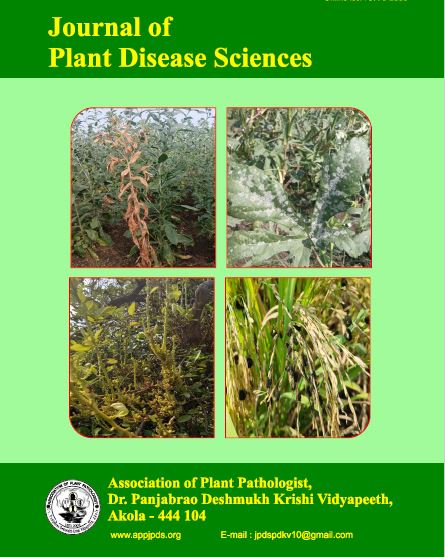ECO-FRIENDLY MANAGEMENT OF LEAF SPOT OF GREEN GRAM CAUSED BY CERCOSPORA CANESCENS
DOI:
https://doi.org/10.48165/jpds.2024.1901.09Keywords:
Bio-agents, Cercospora canescens, Green gram, Phyto-extractsAbstract
The green gram crop is affected by several diseases and the Cercospora canescens causing leaf spot is one of the major diseases causing significant losses. In vitro evaluation of different bioagents and phyto-extracts was carried out to test their efficacy against the test pathogen Cercospora canescens. The seven bioagents (5 fungal and 2 bacterial) viz., Trichodermaasperellum, T. harzianum, T. virens, T. koningii, Aspergillus niger, Pseudomonas fluorescens and Bacillu subtilis were evaluated in vitro for their antifungal activities against leaf spot disease of green gram. Trichoderma harzianum, T. asperellum and T. virens showed effective mycelial growth inhibition i.e. 89.81%, 88.80% and 82.65% respectively, which were significantly superior to the untreated control. Among the seven phyto-extracts tested, the treatments of neem leaf extract and garlic clove extract showed effective mycelial growth inhibition i.e.84.81 % and 82.04 %, respectively which were significantly superior over the untreatedcontrol.
References
Abbaiah, K., 1993: Development of powdery mildew epidemics in urad bean in relation to weather factors. Indian Journalsof Pulses Res., 6:186-188.
Anonymous, 2004: Recommended dietary allowance for Indians. Survey of Indian Agriculture, Pub. The Hindu : pp 54.
Anonymous, 2022: Annual report of All India Coordinated Research Project on Pulses. ICAR- Indian Institute of Pulses Research, Kanpur : pp 45.
Arora, D. K. and R. K. Upadhyaym, 1978: Effect of fungal staling growth substances on colony interaction. Pl. Soil, 49: 685-690.
Barbetti, M. J., 1985: Infection studies with Cercospora zebrine on pasture legumes in western. Australian Journal of Experimental Agriculture, 25: 850-855.
Bharti, M., R. Chandra, A. Kumar, R. Kumar, V. Yadav and P. Yadav, 2017: Enzymatic response of mungbean (vigna radiata) genotypes against Cercospora leaf spot disease. Indian Journal of Agricultural Sciences, 87:930-933.
Dahiya, P. K., A. R. Linneman, M. A. J. S. Van Boekel, N. Kheterpaul, R. B. Grewel and M. J. R. Nout, 2015: Mung bean: Technological and Nutritional Potential. Crit. Rev. Foods Sci. Nutr., 55 (5): 670-
688.
Lal, G., D. Kim, S. Shanmug Sudarshanam, and T. Kalb, 2001: Mung bean production by AVRDC. World Vegetable Centre, Taiwan, Shanhua: pp 6.
Mian, A.L., 1976: Grow more pulse to keepyour pulse well. An essay of Bangladesh pulse, Department of Agronomy, BAU, Mymensingh:11-15.
Munjal, R. L., G. Lal and B. Chona, 1960 : Some Cercospora species from India. Indian Phytopathology, 13 : 144-145.
Nene, Y. L. and P. N. Thapliyal., 1993: Evaluation of fungicides. In: Fungicides in Plant Disease Control, (3rded.) Oxford IBH Pub. Co., New Delhi : pp 531- 532.
Pal, G., K.U. S. P. Bhaskar Kumar, K. Kumari and D. K. Agrawal, 2021: An economic analysis of mung bean seed production technology in Mau district of eastern Uttar Pradesh. Legume Research-An International Journal, 44 : 1260-1264.
Poornima Yashoda, R. Hegde and J. Jagdish, 2011: Biological management of Cercospora beticola. Research Journal of Agricultural Science, 2(3) : 655-657.

